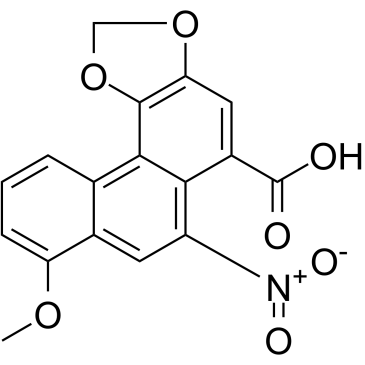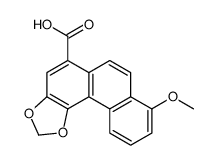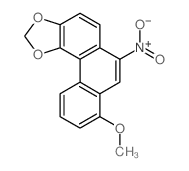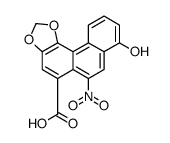Aristolochic acid A

Aristolochic acid A structure
|
Common Name | Aristolochic acid A | ||
|---|---|---|---|---|
| CAS Number | 313-67-7 | Molecular Weight | 341.27 | |
| Density | 1.6±0.1 g/cm3 | Boiling Point | 615.5±55.0 °C at 760 mmHg | |
| Molecular Formula | C17H11NO7 | Melting Point | 260 °C | |
| MSDS | Chinese USA | Flash Point | 326.0±31.5 °C | |
| Symbol |

GHS06 |
Signal Word | Danger | |
Use of Aristolochic acid AAristolochic acid A (Aristolochic acid I) is the main component of plant extract Aristolochic acids, which are found in various herbal plants of genus Aristolochia and Asarum. AAI significantly reduces both activator protein 1 (AP-1) and NF-κB activities. Aristolochic acid A reduces BLCAP gene expression in human cell lines[1]. |
| Name | aristolochic acid |
|---|---|
| Synonym | More Synonyms |
| Description | Aristolochic acid A (Aristolochic acid I) is the main component of plant extract Aristolochic acids, which are found in various herbal plants of genus Aristolochia and Asarum. AAI significantly reduces both activator protein 1 (AP-1) and NF-κB activities. Aristolochic acid A reduces BLCAP gene expression in human cell lines[1]. |
|---|---|
| Related Catalog | |
| In Vitro | Aristolochic acid A (150, 200 μM, 24 hours) inhibits the cell viabilities of kidney cells HEK293 and HK-2[1]. Aristolochic acid A (100, 200 μM, 24 hours) causes a concentration-dependent decrease in bladder cancer-associated protein (BLCAP) mRNA levels in kidney cells (HEK 293 and HK-2) , and bladder cancer cell line (HT-1376)[1]. Aristolochic acid A (100, 200 μM, 24 hours) weakens the BLCAP protein signals in a dose-dependent manner in both HEK293 and HT-1376 cells[1]. Cell Viability Assay[1] Cell Line: Kidney cells (HEK 293 and HK-2) Concentration: 50, 100, 150, 200 μM Incubation Time: 24 hours Result: The cell viabilities of HEK293 and HK-2 were lower than that of vehicle-treated cultures until 150 μM and 200 μM. RT-PCR[1] Cell Line: Kidney cells (HEK 293 and HK-2), and bladder cancer cell line (HT-1376) Concentration: 100, 200 μM Incubation Time: 24 hours Result: Down regulated the levels of BLCAP mRNA. Western Blot Analysis[1] Cell Line: HEK293 and HT-1376 cells Concentration: 100, 200 μM Incubation Time: 24 hours Result: Reduced the BLCAP protein expression in a dose-dependent manner. |
| References |
| Density | 1.6±0.1 g/cm3 |
|---|---|
| Boiling Point | 615.5±55.0 °C at 760 mmHg |
| Melting Point | 260 °C |
| Molecular Formula | C17H11NO7 |
| Molecular Weight | 341.27 |
| Flash Point | 326.0±31.5 °C |
| Exact Mass | 341.053558 |
| PSA | 110.81000 |
| LogP | 3.41 |
| Vapour Pressure | 0.0±1.9 mmHg at 25°C |
| Index of Refraction | 1.747 |
| Water Solubility | DMSO: soluble |
CHEMICAL IDENTIFICATION
HEALTH HAZARD DATAACUTE TOXICITY DATA
MUTATION DATA
|
| Symbol |

GHS06 |
|---|---|
| Signal Word | Danger |
| Hazard Statements | H301 |
| Precautionary Statements | P301 + P310 |
| Personal Protective Equipment | Eyeshields;Faceshields;Gloves;type P2 (EN 143) respirator cartridges |
| Hazard Codes | T:Toxic |
| Risk Phrases | R25 |
| Safety Phrases | S7-S35-S45 |
| RIDADR | UN 1544 6.1/PG 3 |
| WGK Germany | 3 |
| RTECS | CF3325000 |
| Packaging Group | III |
| Hazard Class | 6.1(b) |
|
Bardoxolone methyl (BARD) ameliorates aristolochic acid (AA)-induced acute kidney injury through Nrf2 pathway.
Toxicology 318 , 22-31, (2014) Bardoxolone methyl (BARD) is an antioxidant modulator that acts through induction of the nuclear factor erythroid 2-related factor 2 (Nrf2) signaling pathway. This study aimed to investigate the role ... |
|
|
Baicalin Protects Mice from Aristolochic Acid I-Induced Kidney Injury by Induction of CYP1A through the Aromatic Hydrocarbon Receptor.
Int. J. Mol. Sci. 16 , 16454-68, (2015) Exposure to aristolochic acid I (AAI) can lead to aristolochic acid nephropathy (AAN), Balkan endemic nephropathy (BEN) and urothelial cancer. The induction of hepatic CYP1A, especially CYP1A2, was co... |
|
|
Association of blood lead and mercury with estimated GFR in herbalists after the ban of herbs containing aristolochic acids in Taiwan.
Occup. Environ. Med. 70(8) , 545-51, (2013) This study was undertaken to explore the association of estimated glomerular filtration rate (GFR) with exposure to aristolochic acids (ALAs) and nephrotoxic metals in herbalists after the ban of herb... |
| Aristolohic Acid A |
| Descresept |
| 8-methoxy-3,4-methylenedioxy-10-nitrophenanthrene-1-carboxylic acid |
| Aristolochic acid |
| birthwort |
| Phenanthro[3,4-d]-1,3-dioxole-5-carboxylic acid, 8-methoxy-6-nitro- |
| AristolochicacidI |
| EINECS 206-238-3 |
| Aristolochia |
| tardolyt |
| Aristolochic Acid A |
| Aristolochia A |
| aristolochin |
| 8-Methoxy-6-nitrophenanthro[3,4-d][1,3]dioxole-5-carboxylic acid |
| TR 1736 |
| Aristolochic |
| MFCD00004996 |
| aristolochine |
| 8-Methoxy-6-nitrophenanthro[3,4-d]-1,3-dioxole-5-carboxylic Acid |
 CAS#:13395-02-3
CAS#:13395-02-3 CAS#:35142-05-3
CAS#:35142-05-3 CAS#:3580-56-1
CAS#:3580-56-1![Phenanthro[4,3-d]-1,3-dioxole-5-carboxylicacid, 8-methoxy-6-nitro-, methyl ester structure](https://image.chemsrc.com/caspic/087/1169-60-4.png) CAS#:1169-60-4
CAS#:1169-60-4 CAS#:85814-30-8
CAS#:85814-30-8 CAS#:38965-71-8
CAS#:38965-71-8
